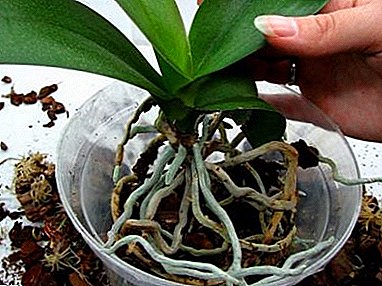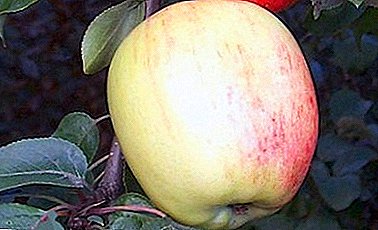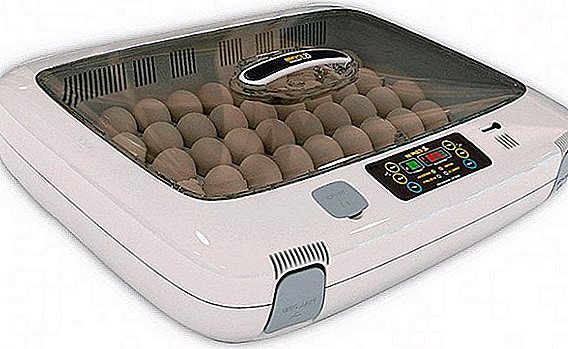 All those who are thinking about large-scale breeding of poultry, first of all pay attention to the "mechanization". Laying is good, but with large volumes such an approach is not justified, and not every chicken will sit quietly in the nest. In such cases, special units are more suitable. We find out how to choose a reliable incubator, based on its characteristics.
All those who are thinking about large-scale breeding of poultry, first of all pay attention to the "mechanization". Laying is good, but with large volumes such an approach is not justified, and not every chicken will sit quietly in the nest. In such cases, special units are more suitable. We find out how to choose a reliable incubator, based on its characteristics.
The number of eggs laid
Such equipment is designed for a different number of eggs for a bookmark. All of them can be divided into such groups:
- Household (designed for 40 - 120 eggs, although offered and 200-seater). They are best suited for a small farm.
- Leadheads (usually in them from 500 to 1000 cells);
- Bulky industrial (from 1000 to 3000 "places").



For the “start” of their own business, a beginning “poultry farmer” will have enough “boxes” for 60 - 80 eggs. This size is the most popular, besides for the first sample more and not needed, this will confirm any farmer.
Important! Before laying the eggs, it is desirable to enlighten: among them may be infertile. To do this, use special flashlights or professional ovoskopov.
Before you choose a good incubator for your household, keep in mind that manufacturers indicate capacity, focusing on chicken eggs. It is clear that for other birds (geese or quails) this figure will be different, in addition, it will also have to be stocked up with additional trays.
Do not chase for cheap. Saved on the purchase of money can turn into expenses during the operation. To avoid this, pay attention to the main nuances of such technology.
Translucent eggs before laying and during incubation is a very important process. The device for ovoskopirovaniya not necessarily buy, you can do it yourself.
The material from which the incubator is made
The best raw material for the manufacture of incubators is considered Styrofoam. It does not absorb moisture, and due to the low thermal conductivity is able to retain heat for a long time. This is true with frequent power outages: in such conditions heat will last 4 to 5 hours.

The foam case is perhaps the best option (of course, if the manufacturer has withstood the technology). But the inner "upholstery" of such material is also not bad. True, there are some downsides: smells are absorbed quite quickly, and it is easily damaged.
Did you know? In the USSR, incubators began to be produced in 1928. These were huge complexes designed for 16 thousand masonry. Names they had to match the time: "Spartak" and "Communard."Popular plastic devices are convenient in cleaning and disinfection. Before laying the masonry, many let in a layer of thermal insulation: plastic in this plan is inferior to foam plastic. It does not interfere with the casting quality: the body should be smooth. Burrs, chips, and even more curved walls suggest that such a product will not withstand intense temperature conditions.

Manufacturer country
Companies from many countries are engaged in the manufacture of incubators, so there is something to choose from. Imported units bribe their elegant appearance and high-quality assembly (with the exception of perhaps the obscure "Chinese"). But they also have a significant drawback in the form of prices. With unhurried operation in home use they will pay off for a very long time.
Read about the intricacies of incubating chickens, goslings, turkey poults, ducks, turkeys, quails.
Therefore, it is better to prefer domestic models. Yes, they lose a little to foreigners in terms of aesthetics, the quality of fitting also sometimes “limps”. But there are no problems with warranty repairs. Add to this the simplicity of the device - if necessary, a failed component can be replaced with your own hands (often self-made units are also used).
Swivel mechanism
For uniform heating, the timely rotation of the eggs plays an important role. In all modern incubators, this is done in one of the following ways:
- Manual. It is not suitable for everyone, with large clutches it takes a lot of time (you have to set eggs separately).
Important! In the manual mode, the purity of the hands is of paramount importance. When an oversight occurs, microbes can easily penetrate the pores of the egg and slow down the development of the embryo.
- Mechanical. It is already easier here - it is enough to turn the handle in time, which rotates the trays with the necessary inclination by means of a lever or a lever. A great choice for beginners.
- Rolling in a horizontal plane (there is a risk of damage).
- Move stationary eggs in roller cells.
- "Industrial" tilt trays by 45 ° vertically.
Did you know? Chickens are not so stupid, as is commonly believed - they are capable of dreaming, and the phases of such rest are similar to human ones. In addition, in the process of evolution, "hens" learned to sleep "slowly": while one half of the brain is asleep, the second works, warning of the appearance of predators.Note that no automation will replace the master's hands - the laying will have to be aired every day and cooled down a bit. However, the manufacturers took into account this moment.
Thermostat
Another pre-purchase question is which thermostat is better suited for an incubator. The answer is obvious: preferably digital. It has clear advantages:
- Exact temperature setting to help avoid underheating or overheating. Specify the accuracy class (the “pitch” can be different - in most cases it is 0.1–0.5 °, although there are quite a few devices with a stroke of 0.01 °).
- Relatively low cost. They are not much more expensive than mechanical ones.
- Easy settings.
Fan and air distributor
Its presence is desirable, but not necessary. The fact is that in the most simple constructions air enters through holes made in the casingthat, in sum, with a working thermostat provides the desired "atmosphere".
Important! In the first 3 - 4 days of masonry ventilation is not carried out. When the camera warms up, on the 4th day, the minimum airflow is made at a humidity of 50%, and after the 5th it is gradually increased, bringing to a maximum of 18 days.Experienced poultry farmers know that for a small-sized incubator a powerful fan is not particularly needed. But for the impressive blocks with a capacity of 60 eggs, they are already needed. It is important and its location. If it is located in the center of the lid, then everything will be normal: the air will calmly reach all angles.

Battery life
Such "abilities" will be only a plus. True, the batteries bundled with expensive devices by themselves cost a lot. When the light is turned off, they work without any problems with reserve power supply units of lower power.
Proper feeding of chickens, goslings, broilers, quails, musk ducks from the first days of life is the basis of their successful breeding.
If you think about it and make calculations, it turns out that the owner of a small home battery is not really needed - for 2-3 hours without electrics foam keeps heat. But not everywhere the work of networks (and repairmen) is stable. Then you have to either shell out, or combine a car battery with an inverter or backup 12-volt equipment. And this also requires costs and skills.
Owners of large appliances, working "for divorce", do not have to choose: they risk nothing, so you can not do without a battery.
Warranty and after-sales service
Check with the seller the terms of the warranty and possible repair - absolutely reliable technology does not happen. Here one more advantage of our appliance is manifested: in some cases, you can directly contact the manufacturers.
Did you know? For every inhabitant of the planet there are 3 hens.Be sure to read the instructions, paying particular attention to the procedure for the first run and mode of operation at this time. Also, do not forget that the buyer has not only rights, but also obligations. In particular, do not rush to immediately make any changes to the device (such a "rationalization" is fraught with voiding the guarantee).
Now our readers know what to look for when choosing. We hope that now you will easily find a reliable home incubator that will work without failures for many years. Good luck in the yard!












